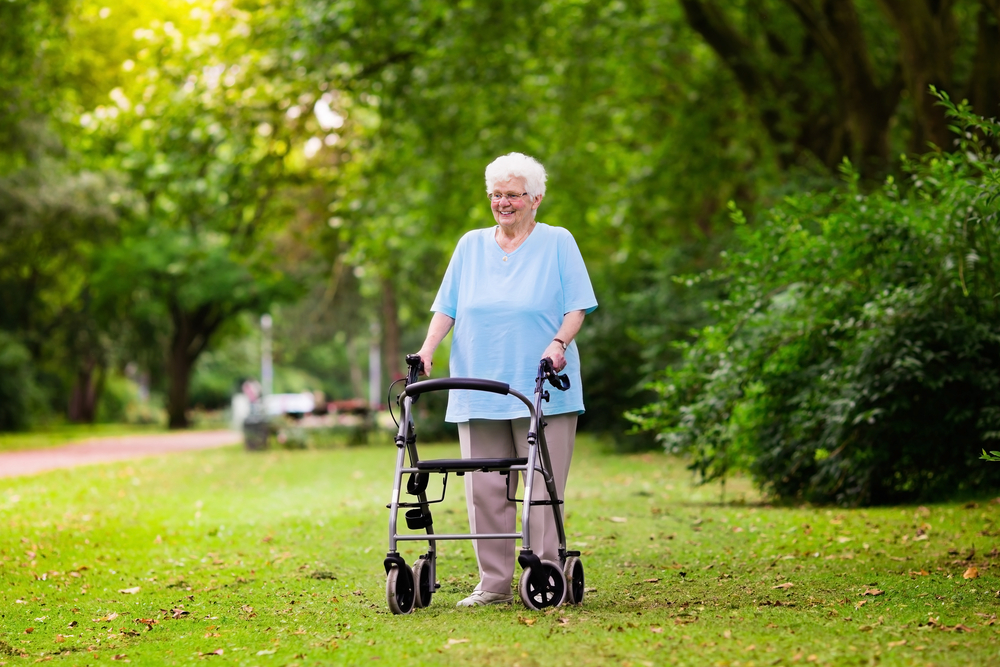Skis, Wheels, or Balls: What Are the Best Feet for Your Walker?
 When you picture a walker, you likely imagine those standard walkers with a simple aluminum frame and tennis balls on the feet. Many people add tennis balls to the legs of their walkers to help them slide more easily over the ground, as well as to make the ends of the legs more visible. But are they really the best option for your walker’s feet? Or are there better options out there? Keep reading to learn the pros and cons of tennis balls, walker skis, and wheels on your walker.
When you picture a walker, you likely imagine those standard walkers with a simple aluminum frame and tennis balls on the feet. Many people add tennis balls to the legs of their walkers to help them slide more easily over the ground, as well as to make the ends of the legs more visible. But are they really the best option for your walker’s feet? Or are there better options out there? Keep reading to learn the pros and cons of tennis balls, walker skis, and wheels on your walker.
Tennis Balls
We’ll start with the simple, classic tennis ball. The most apparent benefit of using these on your walker is that they’re cheap and easy to acquire. You can grab tennis balls from any store that carries sporting goods for a few bucks. Simply cut an X on one side of the ball and slip it on the foot of your walker.
Another benefit of tennis balls is their bright color and the way that they enlarge your walker’s foot. For some senior citizens, depth perception is as much an issue as their mobility. Being able to better see where your walker’s foot ends makes it easier to lift it to an appropriate height and set it down gently. If you struggle to see the walker’s foot, you might not pick it up high enough and end up scuffing it against the ground. Or, you might set it down to firmly, ramming the feet into the ground and making yourself stumble.
Tennis balls also provide a small reduction in the friction of your walker’s feet. This makes it a little bit easier to push your walker along without having to lift it quite so much. However, it’s not a very large reduction in traction; so, if you struggle with lifting your walker, tennis balls probably aren’t the right solution for you.
Walker Skis
Also known as ski glides and ski gliders, these small plastic attachments pop right onto your walker’s legs and provide a smoother surface for easier movement. As you can probably guess from their name, these attachments are ski-shaped and made to help your walker glide over smooth surfaces.
These caps can reduce the amount of friction on your walker’s feet more than tennis balls usually can. This means that, when walking over relatively smooth surfaces, you’ll likely be able to slide your walker forward rather than having to lift it. This can be incredibly helpful if you primarily use your walker indoors, as the skis will glide quite well over carpet, hardwood, tile, and other types of indoor flooring.
However, if you struggle with depth perception, skis won’t help you with seeing the ends of your walker’s feet. There are different versions of walker glides out there, including some that are made to look like colorful sneakers. These more brightly colored versions may help with depth perception issues more than standard walker skis, and they make for a great conversation starter too!
It’s also important to note that skis won’t allow you to push your walker forward on uneven surfaces. So, if you need a walker you can use outdoors, on more uneven terrain, this isn’t the best solution.
Wheels
While wheels can’t typically be attached to a standard walker, there are wheeled versions of walkers available for purchase. These are typically referred to as rollator walkers, and they can have wheels on only the front two feet, or on all four. There are pros and cons to both configurations.
Having wheels on all four of your walker’s feet obviously allows for it to move forward very easily without you having to lift the walker at all. The wheels also typically navigate over rough terrain fairly well. However, for some individuals, a four-wheeled walker moves a bit too easily, and they may find their walker rolling away from them. These walkers are also not intended to be heavily leaned on, so if you need a great deal of support when walking, you don’t want four wheels. Rather, this walker is ideal for people who just need a bit of help with their balance while walking.
Two-wheeled walkers offer a bit of both worlds. While you do have to lift the back end of the walker, it still rolls forward quite easily over most surfaces. You can lean on these walkers a bit more heavily as well. Both versions of rollator walkers also often have a built-in seat, which is ideal if you need a rest while you’re out walking.
If you’d like to test out various walkers to find the best fit for you, stop by a Medical Xpress location today!